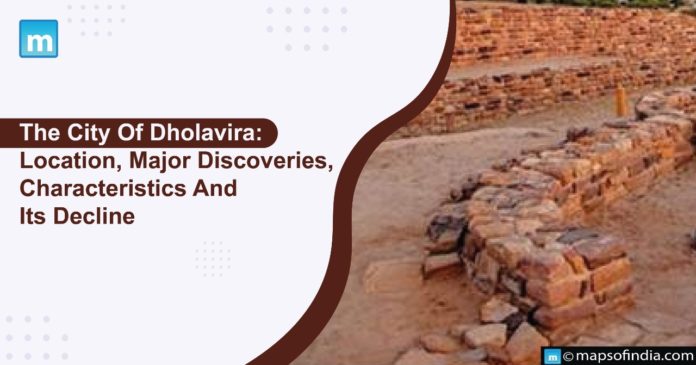It is one of South Asia’s most impressive and well-preserved urban historic sites. Its discovery was made in 1968 by Jagat Pati Joshi, an Indian archaeologist. Dholavira is the fifth-largest Indus Valley Civilization (IVC) city after Mohenjo-Daro, Harappa, and Ganweriwala in Pakistan and Rakhigarhi in India’s Haryana.
IVC was thriving in what is now Pakistan and Western India, in the western portion of South Asia, during 2,500 BC. It was primarily an urban civilization where people lived in well-built, well-planned cities that served as the hubs of commerce. An old IVC/Harappan city’s ruins might be found at the location. It is divided into two sections: an enclosed city and a gravesite in the west portion of the town.
The fortified Castle and its adjacent consolidated Bailey and Ceremonial Ground fortified Middle Town and Lower Town make up the walled city. Several large reservoirs are south and east of the fortified castle, popularly known as the Citadel.
Location
The archaeological site of the old city of Dholavira, located in Gujarat’s Kachchh District, dates from the third to the middle of the second millennium BCE. Dholavira’s location is at the Tropic of Cancer.
It is situated on Khadir Bet Island in the Great Rann of Kachchh Desert Wildlife Sanctuary. The town of Dholavira is situated on the island of Khadir Bet, in contrast to other Harappan predecessor cities, which are often found close to rivers and year-round water supplies. The city is well known for Utilizing several mineral and raw materials such as shell, agate-carnelian, copper, steatite, and banded limestone, among others.
Additionally, it permitted internal and external trade with Mesopotamia and the Magan (the current Oman peninsula).
Archaeological discoveries
- Terracotta ceramics, beads, decorations made of gold and copper, inscriptions, fish hooks, animal figures, tools, urns, and a few imported vessels are among the artefacts discovered here.
- Remains of a copper smelter show that the Dholavira-dwelling Harappans were proficient in metallurgy.
- The traders of Dholavira are said to have imported final goods from the UAE, Oman, and the present-day states of Rajasthan, where copper ore is found.
- In addition to producing jewellery out of shells and semi-precious minerals like agate, it was also a significant exporter of wood.
- The world’s oldest sign board with 10 massive stone inscriptions written in Indus Valley script was also discovered.
Unique Characteristics of the Dholavira Complex
- Reservoirs in a flowing succession.
- Exterior fortification.
- Two multipurpose areas, one of which served as a venue for events and the other as a market.
- Nine gates with distinctive patterns.
- Tumulus, hemispherical monuments resembling Buddhist stupas, are a common feature in funerary architecture.
- Defence systems with several layers, an abundance of stone in the structure, and unique burial structures.
Remarkable water management systems
- The elaborate water management system built to store every drop of accessible water demonstrates the inventiveness of the inhabitants to endure the quick geo-climatic changes.
- Large stone-cut reservoirs still present along the eastern and southern walls were used to obtain and store water diverted from seasonal streams, little precipitation, and accessible terrain.
- Among the oldest examples, a few rock-cut wells may be seen throughout the city for additional water access; the most notable is in the Citadel.
- Dholavira’s complex water conservation strategies are exceptional and rank among the most effective ones from ancient times.
Factors leading to its decline
- Its demise also occurred at the same time Mesopotamia fell, demonstrating economic interconnectivity.
- When Mesopotamia collapsed, the maritime Harappans lost a sizable market, which impacted the local quarrying, manufacturing, marketing, and export industries.
- Due to climate modifications and the drying up of rivers like the Saraswati, Dholavira experienced a period of extreme aridity.
- Due to the drought, people migrated into the Ganges valley, south Gujarat, and Maharashtra.
- Additionally, the Great Rann of Kutch, which encircles the Khadir island where Dholavira is situated, was formerly navigable but has since turned into a mudflat due to the sea’s slow retreat.
Dholavira’s Current Situation
Gujarat’s Dholavira, a Harappan city, was designated as India’s 40th world historical site by UNESCO in 2021. It is India’s first Indus Valley Civilization (IVC) site to make the prestigious list. India now joins the Super-40 group for World Heritage Site inscriptions.
Besides India, countries with 40 or more World Heritage Sites include Italy, Germany, China, Spain, and France. India is home to 40 world heritage sites, including 32 cultural sites, seven natural sites, and one mixed site.




